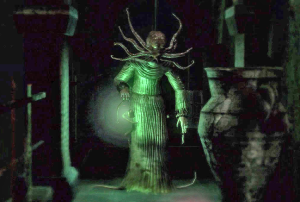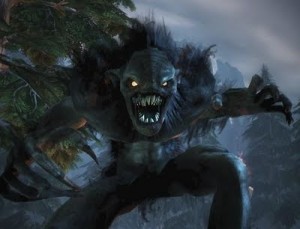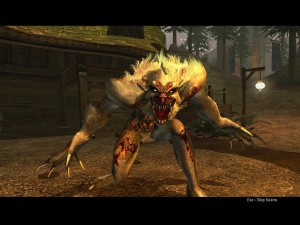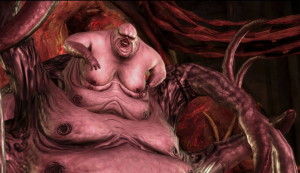Horror Elements in Non-Horror Games
by Phoenix, HSM team writer
Have you ever played a game that wasn’t a survival horror game, but had elements of horror in it? There are a few games, classified as simply RPG, that have elements of survival horror that can give you a scary moment here and there. I can name a few that I have played which include elements of suspense, and creatures right out of a nightmare.
Consider the Brood Mother from Dragon Age, a multiplatform game. With her many over-large teats and voluminous mounds of flabby tainted flesh, and the fleshy tentacles that reach far too far and whip you defenseless, she’s a visual nightmare — and a fighting one, as well. For sheer grotesque appearance, the Brood Mother and her attacking dead babies that turn into Darkspawn, the ulcerated flesh walls of her lair and the rivers of spewing blood and acid vomit, are a must for sheer horror. If you have never played Dragon Age, believe me when I say the Brood Mother is one of a few things in that game that can totally creep you out.
 Then there is the Mind Flayer. This creature is at its newest creepy rendering in Demon Souls, a PlayStation 3 game, but versions of it can be found in several other games, such as the Final Fantasy series. The Mind Flayer was first depicted in 1974, created by Gary Gygax for Dungeons and Dragons 1974-1999. It appeared in the Strategic Review in 1975. It is a humanoid creature with tentacles protruding from either side of its mouth. The tentacles lash out and strike the victim in the head, to pull the brain forward so the Flayer can devour the mind.
Then there is the Mind Flayer. This creature is at its newest creepy rendering in Demon Souls, a PlayStation 3 game, but versions of it can be found in several other games, such as the Final Fantasy series. The Mind Flayer was first depicted in 1974, created by Gary Gygax for Dungeons and Dragons 1974-1999. It appeared in the Strategic Review in 1975. It is a humanoid creature with tentacles protruding from either side of its mouth. The tentacles lash out and strike the victim in the head, to pull the brain forward so the Flayer can devour the mind.
Gygax has said he was inspired to create this creature by the cover of Brian Lumley’s book, The Burrowers Beneath. Lumley’s story was, in turn, grounded in H.P. Lovecraft’s Cthulhu Mythos. Lovecraft, an American writer of horror, fantasy, poetry, sci-fi and a genre know as weird fiction, is perhaps best known for his notable short stories, such as “The Dunwich Horror”, and “Dagon”.
The mind flayer isn’t so much an abhorrent apparition as it is the idea of creature with way too many forms of reach. It has too many ways to overpower and capture you. To beat this thing, and to survive, you have to keep be quick enough to eliminate all the extra tentacles and arms.
The Fable series of games are not considered horror survival games. They’re not PlayStation games either, being confined to Xbox, Mac OS X and Microsoft Windows platforms. But they have one of the most frightening creatures to fight: the Balverine. As I have said before, I have played very few games to completion. Fable, the first game of the series, was one that I did finish. I have to admit it was a very interesting experience. It was my first role-playing game with a monster aspect. I had been encouraged by my son to try the game, and I did.
In most role-playing games, there are main quests and side quests, and Fable is no exception. Up until this time I had played one level of Zelda: Majora’s Mask, Beyond Good and Evil, and Sphinx and the Cursed Mummy. When I started to play Fable it was because it had several things I liked — beautiful backdrops, a Medieval appearance and a soundtrack that still pulls me in. The demon doors have a kind of Celtic design and appeal for me. For the most part, I enjoyed playing the game just to be in the forest and towns.
The game is set in the fictional world nation of Albion, a city state with wide spreading rural areas and wilderness. It’s a Medieval world, with something like the look and feel of England in that time. This makes sense — Fable’s developer is Lionhead Studios, a British studio. The name Albion was the oldest name given to the English island of Great Britain.
 I had done some minor quests, and was not actually playing the main storyline, just sightseeing as I traveled through the forest and countryside. So I was taken completely by surprise when I first encountered the Balverine. I suppose I shouldn’t have been, considering the legends of the time and having seen ghosts and lost spirits in cottages and some spectral combatants in the game so far. But I was completely thrown off guard by the appearance of the Balverine. Remember, it was the first time I had played this type of game or seen this type of creature. I was shocked and freaked out by its sudden attack and the subsequent merciless death it dealt me.
I had done some minor quests, and was not actually playing the main storyline, just sightseeing as I traveled through the forest and countryside. So I was taken completely by surprise when I first encountered the Balverine. I suppose I shouldn’t have been, considering the legends of the time and having seen ghosts and lost spirits in cottages and some spectral combatants in the game so far. But I was completely thrown off guard by the appearance of the Balverine. Remember, it was the first time I had played this type of game or seen this type of creature. I was shocked and freaked out by its sudden attack and the subsequent merciless death it dealt me.
I was so caught up in the quick — and I mean quick — fight that took place, I found myself shaken and spooked. My hands trembled as I gripped the controller and I remember my fingers floundering for the correct combination of X, Y, B, A to stave off the blood-thirsty hordes of Balverine attacking the village I was in. I can remember my thoughts and hear myself shouting obscenities, all the while trying to fight the thing, and then running from it, only to be caught and ripped to shreds.
After my initial loss to the Balverine I sat there staring at the screen. I kept asking myself, what just happened? I had not expected something like a werewolf in a video game. But, despite the scare, this was a great, amazing discovery. I loved werewolves! They are the most savage and unforgiving, calculating yet mindless, primal and instinctual killing machines ever! I never thought I’d get to fight and or run one from one in a game. The Balverine left me shaken and pretty much afraid to wander the forest of Albion again. Though I finished the game eventually, I never forgot the numerous losses I took to the Balverine.
 A Balverine is depicted and described as sharing some characteristics of werewolves. They are man-like creatures, running on all fours at times and standing and fighting on two legs. I suppose that’s why I like them. They have fur in the colors of black or brown, except for the legendary white Balverine, and they all have yellow eyes and sharp teeth. The white Balverine was the first Balverine; it is from him that the species line derived. The Balverine and werewolf share the vulnerability to silver. Balverines, however, have no snouts, and have far less hair then werewolves. Both are several times stronger than a man.
A Balverine is depicted and described as sharing some characteristics of werewolves. They are man-like creatures, running on all fours at times and standing and fighting on two legs. I suppose that’s why I like them. They have fur in the colors of black or brown, except for the legendary white Balverine, and they all have yellow eyes and sharp teeth. The white Balverine was the first Balverine; it is from him that the species line derived. The Balverine and werewolf share the vulnerability to silver. Balverines, however, have no snouts, and have far less hair then werewolves. Both are several times stronger than a man.
Balverines attack with claws out and can jump high into the air — which they do, landing behind you, slashing you as you try to figure where they went. For me, Balverines are the best part of the Fable series. It was a learning experience, for sure.
I have since played a few other games where I battled creatures straight out of a nightmare, but this one I will always remember. I have not had anything remotely like it to fight until I encountered the Xenomorphs of Aliens. Let’s not dwell too long on these encounters, as they are quite frightening — even for a video game.
Horror doesn’t always come in a nice, genre-defined package; sometimes elements of it seep into other games and other experiences. Which, paradoxically, can make them even more horrific.
Share
| Tweet |



It all comes down to D&D when it comes to Horror in RPGs. Infact, the Mindflayer in Demons Souls is a perfect example of this, as it can be found in the D&D Monster Manual. In fact Abberations are a whole subcatergory of monsters in D&D. Another cool reference to check out from that universe would be the Ravenloft series of D&D campaigns, as it usually deals with Vampires, Werewolves and Undead.
Dragon Age itself is actually the spiritual successor to Bio-Ware’s Baldur’s Gate series on the PC, which uses the D20 engine since its also D&D game based in the Forgotten Realms Campaign setting. The reason why Dragon Age is a spiritual succesor is because the game play is similar but they no longer have the right to make games under the D&D license.
The Diablo series is also another RPG that has used Horror as a theme in some levels, mainly Gothic Horror. Just take a look at bosses like Andariel and Duriel and theevidence is clear.
Also, other genres have used horror as well. Games like ID software’s Doom series, Castlevania, and Magic the Gathering all gain heavy inspiration from horror.
What it all comes down to is style and art history. Inspiration inspires more Inspiration. The Romans for example used Spoila (The Spoils of War) in certain arches like the Arch of Constantine which was a collection of other art (unfortunately stolen) from around the world to create something new. It was their way of collaging a piece together. Looking throughout the Renassiance, art was inspired from Ancient Greece, yet new techniques were adopted to bring these classic tales back to life.
The same thing happens in the Video Game industry because weather some people want to admit it or not, Video Games are Art due to the fact that they are a mix of writing, artwork, music and code created from someones imagination. As a result, in this day and age, Genres usually boil down to sub-genres because of their ecletic mix of elements from other games. This is how old experiences become new again
Too true, looking at the art in video games was what drew me to them. I admit I am drawn to the depictions of surrealist art. Those works of art that have a dream/ nightmare veil in which the work gives off a sublime and terrible feeling. Games like Silent Hill and Dante’s Inferno have a Max Ernst, Edward Much feel to them.
I played Baulder’s Gate on PS2. I found dungeons and the things that dwelt there did have a visceral effect, it becomes the automatism of Surrealism. The nightmares are no longer confined to ghost or the spirits. The darkness yields other haunting visages.
As you can tell I have a fondness for the surreal, it shows in my art. Though the movement started in the 1920s it has some roots in the chaotic works of the Middle Ages and Renaissance with the visions of Hell and torture for those that left the path of light and ventured into the dark. The Ladder of Souls, with seven Deadly Sins c.1200 Chaldon Surry, is one such depiction.
By some standards the more immersive games have this theme. This is were video games have the characteristics attributed to the surrealist automatism, images shift and change automatically from one horror into another, described by Andre Berton, some games play on the psyche and are therefore perfect forms of surrealism. Art here has no boundaries, and imitation is a nod to the artist that came before.
Fallout: Deathclaws.
Possibly one of my most feared creatures in any game. Not, shriek-like-a-little-girl-and-run kinda fear but simply a one-hit kill thing. Those and Yowgui’s (or however you spell them).
I’ve found that I’ve never been afraid of anything simply for its appearance, ever. It’s what it can DO to me that measures my fear of something. Which is why I cautiously edged my way through the first Silent Hill, and plowed my way through Resident Evil; big, shuffling, grotesque moaning zombies (when you have a shiny big gun) are almost comical. A first aid kit for sewing your face back on and a crowbar to swipe at stuff that moves in the dark, that can kill you with one swipe however puts me into “nervous mode”. Couple that with only knowing something’s around you because of radio static and you have tension, apprehension and yes, fear.
Peering into a foggy, dark street, KNOWING that SOMETHING that will kill you if make a wrong move is far more freaky than “oh look, a hoard of zombies! Pass the minigun”. When the tension is built properly, even a fluffy bunny can be scarier than some wall-crawling, salivating alien with claws for hands -- and Silent Hill knows this.
On the other hand, there’s always Costume Quest! Check PSN for a super fun little Halloween game people!
HAPPY HALLOWEEN!